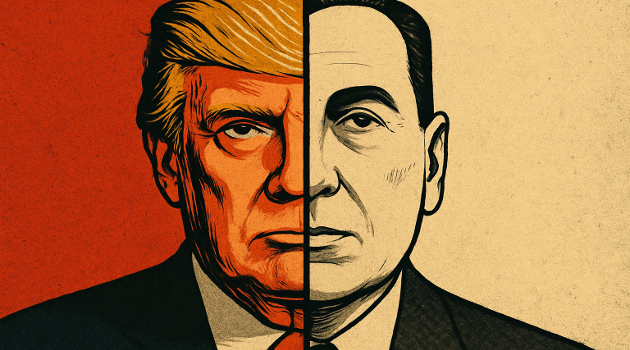Argentina has been an unfortunate member of the Anti-Convergence Club, having been featured once in 2018 and twice in 2023 (here and here).
Today’s column will start by making Argentina a four-time member. As you can see from the chart (based on the Maddison data), the U.S. and Argentina basically had similar growth trajectories in the first half of the 20th century.

America held a lead, but Argentina kept pace.
But then Juan Peron took over Argentina in 1946 and set that nation on a very unfortunate path of terrible policy.
Cronyism, protectionism, statism, and interventionism exacted a heavy price.
Growth stagnated so much during the era of Peronist policy (which unfortunately continued after his death) that the United States opened up a gigantic lead.
Is it possible, however, that this anti-convergence will be reversed?
That’s one implication of Ross Levine’s recent column in the Washington Post. Here are some passages.
The United States is drifting toward the interventionist policy mix behind Argentina’s economic decline just as Argentina is embracing the free-market playbook that powered America’s success. …After Juan Perón became president in 1946, Argentina…cowered behind protective tariffs, nationalized many industries, brought the central bank and the judiciary under presidential control and ran massive fiscal deficits. …He erected high tariffs…state-controlled commercial banks funneled cheap credit to favored industries. …Argentina’s fiscal and monetary populism — spending surges financed by the central bank printing money — produced chronically high, sometimes explosive, inflation and economic chaos. …Buenos Aires is now attempting a reversal. In December 2023, Argentines handed the libertarian economist Javier Milei the keys to…the Argentine White House. Since then, his government has reduced trade barriers, repealed price-setting controls, trimmed subsidies, started privatizing state-owned enterprises, cut government spending enough to log a surplus and brought monthly inflation down… Meanwhile, across the equator, the United States is flirting with Perón-style economics. Debt has soared from 60 percent of GDP before 2008 to roughly 120 percent today. …Washington’s tariff run-up echoes Argentina’s old protectionism. Equally worrying are President Donald Trump’s executive order to tighten White House control over the Federal Reserve — another parallel with Peronism. The recent Chips and Science Act and the Inflation Reduction Act, which shower tax credits and subsidies on favored sectors, are also concerning. …Argentina’s course correction deserves applause; America’s recent detours invite concern. In this Great Reversal, one nation is learning from history; the other is inching toward repeating it.
Similar points were made in Gregory Makoff’s column earlier this year in the New York Times. Here are some passages.
Mr. Trump…and Mr. Milei…are taking their countries in very different directions. Mr. Milei’s administration is restructuring Argentina’s government for good reason: failure. In the early 1900s, people used the expression “as rich as an Argentine,” and millions of Italians and Spaniards immigrated there in hopes of a better life. But soon after, populist, nationalist politics took hold. In 1946, the strongman Juan Domingo Perón took control and his party perfected the art of channeling government cash flows to its supporters. This game ended badly for Argentina, with the political machine demanding more and more money before every election, which led to overspending and a repeat cycle of boom, bust, devaluation and default — all the way until 2020. Argentina’s G.D.P. per capita, once among the world’s highest, is now a small fraction of Italy’s and of Spain’s. …Unlike his Peronist predecessors, Mr. Milei didn’t blame aging generals and foreign lenders for the country’s ills. Instead, he told the truth. He said that Argentina’s government spent too much, forcing it to print more money, which in turn led to inflation and ultimately default. His solution was to cut the budget, and that is what he has done since coming into office… Unlike Mr. Milei — who brought out the chain saw to reach a specific budget target to stabilize his economy — Mr. Trump has been celebrating the use of his power…he’s taking us on the Peronist path, where power politics matters more than good policy. As Argentina teaches us, 100 years of misery could follow if the rule of law is replaced by the rule of one.
If Levine and Makoff are correct about America becoming Peronist and Argentina becoming free market (definitely Milei’s intention), then it is quite likely that the above chart will look much different in the future.
Assuming Milei succeeds (and there are still big obstacles) and and assuming the U.S. continues to become more statist, the next 75 years could look like this.

My lines are purely speculative, of course. And they are based on two assumptions that might not be realistic.
- The U.S. line assumes consistently bad policy over the next 75 years. I’m pessimistic about the future of economic liberty in America, but I do not think that our policies will be as bad as Peronism. At least not on a consistent basis.
- The Argentinian line assumes consistently good policy over the next 75 years. I have faith that policy will be good while Milei is in office, but it might not be reasonable to think Argentina will have a series of future libertarian leaders.
The bottom line is that there will be some convergence in the near future because of Milei’s excellent reforms, but don’t hold your breath waiting for the lines to cross.
I’ll close by observing that both Levine and Makoff obviously disapprove of Trump’s approach to governance.
For all intents and purposes, their columns are more elaborate and more detailed versions of this tweet.

Since I’m very critical of Trump’s trade policy and mostly critical of his spending policy, nobody can accuse me of being a GOP apologist.
That being said, I don’t think Trump is nearly as bad as Peron.
However, if a Trump presidency is followed by an AOC presidency (humorously depicted here) or something similarly awful (humorously depicted here), then the U.S. very well might wind up on the stagnation trajectory in the second chart.



